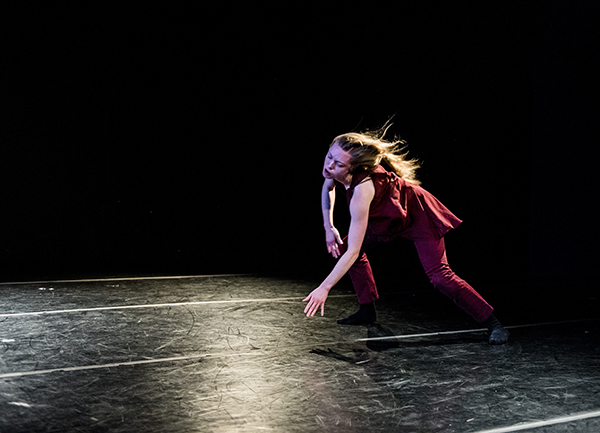Citadel Dance Mix 18: Cummings, Mehaffey and Hoskins


Citadel Dance Mix 18
Works by Allison Cummings, Tori Mehaffey and DA Hoskins
The Citadel, Toronto
November 21-24 & November 28-December 1, 2018
Reviewed by Beverley Daurio and Ted Fox
Allison Cummings’ new short work, As She Shall Obtain Such Command of Her Mass Vein Passageways, is, like its title, an intriguing and very abstract dance made from emotional, intellectual and exploratory ingredients. A solo for Kaitlin Standeven, performed with live music created by Valerie Calam, this is a focused, polished and difficult work: challenging in its physicality for the dancer, and challenging for the audience in its notional and philosophical intensity.
The musician is seated at the front, at the audience’s left; the stage is bare except for two sculptural objects. Toward the back, on the same side as the musician, there is a hanging “king” sculpture (crown, plus metal neck and ribs, with thick ribbons trailing below)—through which Standeven peers at us at the beginning of the piece—and on the other side of the stage, a kind of knobby, gangly sculpture that is like an imaginary metal plant with a glass heart at the top.
Standeven is incrediblly lithe and powerful in her ambulatory travels back and forth across the stage, zigzagging, bumping, rushing awkwardly—on her knees, or bent backwards, scrambling, pulled by her arms, in a harsh crouch—and she is constantly expressing a deep discomfort and pain, that is pushed through, dealt with, by her relentless progress. Every step is about balance—how is balance made, kept, what is it?—with complex ways of meaning. At the end, when she touches the metal plant sculpture, her arrival is felt. The soundscape is a strong and upholding companion to the movement; it works in sections that create another layer of shapes that define different segments of the work. The piece is an embodiment of how we move through difficulty, how we manage, using the imaginary; it is both earthy and transcendent.
Tori Mehaffey’s Avoidance is a refreshing and charming ensemble piece that works on many levels. Luke Garwood, Daniel Gomez, Connor Mitton and Kelly Shaw are dressed up in suits, with energy. Initially one sees the dancers all dressed in white, giving the feel of being in an asylum. The colour suggests innocence, their bodies a blank slate. Their movements are stiff and awkward. A lone chair is onstage, painted an angry or passionate intense colour of red. They move in and around it, curious and attracted by it, in awe, yet also disturbed by it and avoiding interaction. Each takes a turn trying to put the other on them. The chair's presence takes on a personality of its own. At times, they converge around the chair, that gathers and emits emotion under a confection of fluorescent lights, the largest part of which is unlit and looks like a neural network hung from the ceiling. There are moments of humour in duets, trios, and ensemble trips around the stage—especially in some odd lifts, funny gaits and interactions with the chair— and drama as the troupe approaches, avoids, hides behind and even seems to worship The Chair, that takes on a kind of iconic or cargo cult personality at the centre of the dance.
DA Hoskins’ Lady Baby, performed by Danielle Baskerville, Brodie Stevenson and Sebastien Provencher, is a moving, ardent, wild and intense revisioning of an earlier work based on a related theme—the love of certain moments in mainly American film, where actresses are like goddesses. We watch Garbo and other silver screen idols in their condensed and shaped beauty on the screen at the back of the stage, while the beautiful performers—Baskerville, Stevenson and Provencher—are mutable, fascinating and scintillating on stage. They discuss and are discussed as sissy boys. Lady Baby reaches deeply into the connection between men’s beauty and women’s beauty, and how the Masculine in our culture wounds and oppresses non-conformity and seeks to destroy that link.
The piece also explores two contemporary Canadian texts, one abstract, widely spaced and lovely by Jordan Tannahill, and one by Jill Battson, a dirge in angry spoken word that literally calls out and seeks to shame those who abuse other men for not exuding an Ideal of Masculinity that is socially sanctioned. There are strange resonances here and a limning of both ugly and gorgeous excess; many women in the audience may feel a similar twinge at the Ideal of Femininity reproduced again and again on screen, clearly adored by the male dancers; but this piece is not really about women. It is complicated, evokes emotion, and is sharp and brave.
Citadel Dance Mix 18 was one of the most innovative anthology shows we saw in 2018; kudos to curator Laurence Lemieux for providing space and support for such edgy, pushing-the-boundaries work here in Toronto.

